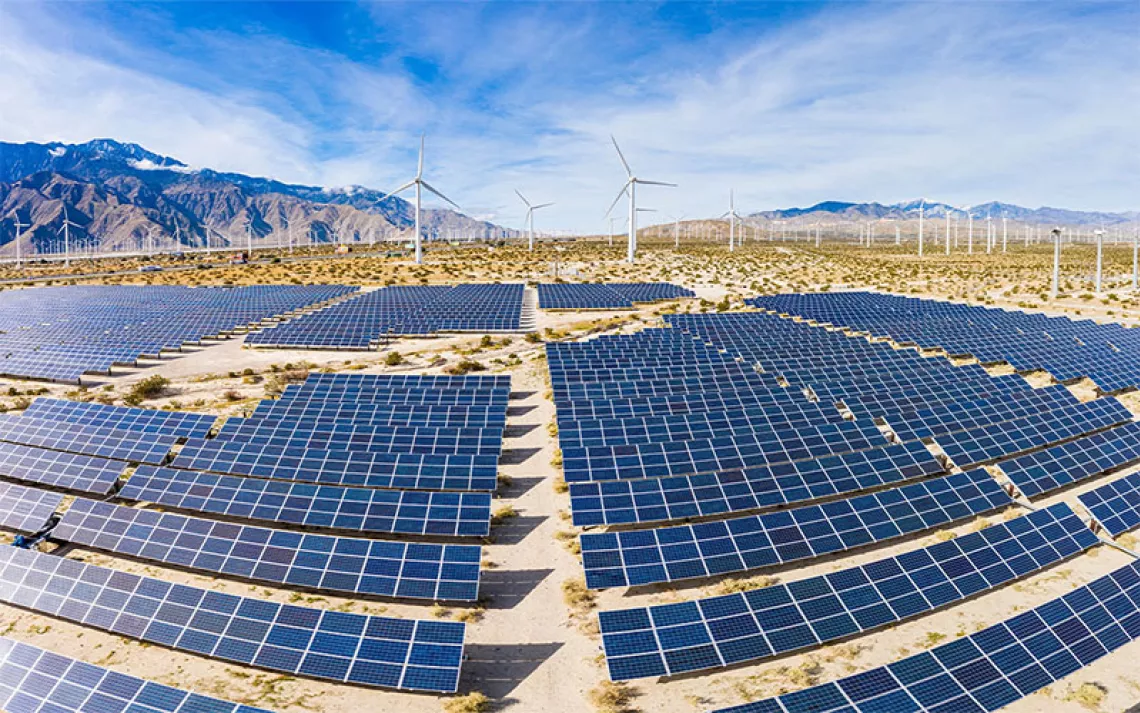Solar Power Is Blooming in Minnesota
The state’s solar gardens are a model for community-level energy generation

Photo by XXLPhoto/iStock
“Our cattle business was our past,” says Ralph Kaehler, whose family has farmed land along the steep bluffs of the Upper Mississippi River in Minnesota for 136 years. “Our future is the solar business.”
The K-Ler Cattle Company’s main business is selling stock bulls and cows, intended for breeding, to clients all over the United States and in countries including Cuba and China. But in 2012, Kaehler’s son, Cliff, quit a job on Wall Street in the renewable energy sector and convinced his father to help him start a solar business in this rural corner of Minnesota. A year later, the state legislature passed a law establishing one of the first and most comprehensive community “solar garden” programs in the country. The program lets community groups, local governments, schools, church congregations, individuals, and businesses share the profits and costs by purchasing subscriptions to projects that generate solar power. Essentially, a solar garden is like a cross between a farm share, an investment, and a tiny mortgage loan.
The program only applies to the areas served by XCel Energy, the state’s largest energy utility. But that has put solar development within reach of many of Cliff and Ralph Kaehler’s ideal clients: Minnesota farmers and others living in the rural Midwest. In recent years, the solar market in Minnesota has grown like a weed, and the state is rapidly becoming a leader in small-scale community solar.
Brian Vetter, a corn, soy, and alfalfa farmer who also raises cattle and hogs in south-central Minnesota, long dreamed of lighting up his farm with solar panels. The farm spanned two counties and two different utility providers, one of which, the local electric cooperative, had hamstrung solar projects with rules that made them financially unworkable. When the solar garden program launched, he and Ralph and Cliff Kaehler put together an application to install a 40-KW array next to two hog barns on another section of Vetter’s land served by XCel. Vetter owns the solar array and also signed up for a residential subscription for his house, commercial subscriptions for both his barns (one of which is co-owned by his cousins), and two subscriptions for his neighbors. In 2015, his farm was the first community solar garden under XCel Energy’s new program. Today, this program has more than 50 solar gardens up and running, churning out more than 200 MW of power.
Minnesota’s solar garden policy was patterned after a program pioneered in Colorado in 2010. It allows developers to use a subscription model to finance solar projects that range in size from one kilowatt (which could be produced by a handful of solar panels) to one megawatt (amounting to a few acres of land and enough to power about 100 to 150 homes). A developer installs and often owns the solar. Subscribers typically pay the owner back for the installation costs via a monthly fee spread over a 25-year contract term. They also see a credit on their utility bill for the solar energy produced every month. Overall, a subscriber saves more in energy costs than he or she pays back to the developer. The model makes solar energy accessible to more people, including some who couldn’t otherwise come up with the capital to put up their own panels. In the past few years, several other states—including New York, Massachusetts, Hawaii, and Illinois—have passed laws enabling solar garden programs.
But Minnesota’s is currently the biggest and arguably most successful, in part because it places no upper limits on the amount of solar that can be developed in the state. “The success speaks for itself at this point,” says John Farrell, a Minneapolis-based energy expert for the Institute for Local Self-Reliance. “We’ve got more community solar than any other state. We’re going to continue to lead for quite a while.” Although Minnesota is hardly known for sunny weather, so far its residents seem to have an insatiable appetite for solar energy production. While solar is still a small fraction of the state’s energy supply, in the first quarter of 2017 alone, the state’s solar capacity surged by 80 percent. At the end of 2015 Minnesota had about 37 megawatts of solar power; by September 2017, the state was churning out more than 550 megawatts of power from the sun. And by the end of November, there were 188 additional community solar projects slated for development in XCel’s territory — totaling 469 megawatts.
The program has been both an economic boon, and, according to some solar proponents, a means of democratizing energy in Minnesota, putting decisions about electricity production into the hands of community members.
When Pax Christi Catholic Church, in the Minneapolis suburb of Eden Prairie, was erected in the 1980s, the building was specifically engineered to hold solar panels, a reflection of church leaders’ long-time interest in environmentalism. “It’s really part of our social teaching,” says Ken Reineccius, the church’s director of operations. “We want to walk the talk when we talk about protecting God’s creation.” But for three decades, buying solar panels wasn’t financially feasible for the church. Now, Pax Christi is finally able to offer up its roof for lease to a member-owned solar developer called Cooperative Energy Futures. The project will produce electricity for about two dozen solar-garden subscribers, including church members and the city of Eden Prairie. The church expects the solar project to be up and running by spring 2018. Members of other Catholic congregations occasionally drop by and ask about the project and whether they should consider setting up their own solar gardens.
While the state solar-garden policy only applies to XCel, customers of electric cooperatives throughout the state have also begun clamoring for their own community solar installations. Over the last two years, a community environmental group in Grand Rapids, in northern Minnesota, has made appearances at churches, service clubs, and city council and local public utilities commission meetings, trying to drum up demand for a one-megawatt solar project there. In August, the group, called the Itasca Clean Energy Team, ran a booth at the county fair and gave away stickers and leaflets about solar to the crowds of fair-goers. William Schnell, a retired state forester who volunteers with the group, says locals have been enthusiastic and the public utilities commission cautiously encouraging. He thinks solar is inevitably part of northern Minnesota’s future. “Solar’s coming to town. It’s just a question of which form it takes,” he says.
Meanwhile, Brian Vetter’s first solar project was so successful that he’s leased another 15 acres of his farm to an investor that is installing a 3 MW array. Vetter sees it all as a way of diversifying his farming business. “Now we’re farming the sun,” he says.
Ralph Kaehler thinks these projects are just the beginning. Solar technology has become vastly more affordable in recent years. Because of policies like the solar-garden program, solar energy is no longer an enterprise solely for wealthy do-gooders, he insists, but an appealing way to bring business into a community. “If we went out 10 years ago or 15 years ago to a business or farmer and talked about solar, they’d say, you know, you’re too expensive and I’m not a hippie,” he says. “Now what we tell people, you can do what’s right and make money—and there is nothing wrong with that.”
This article has been updated since publication.
 The Magazine of The Sierra Club
The Magazine of The Sierra Club



